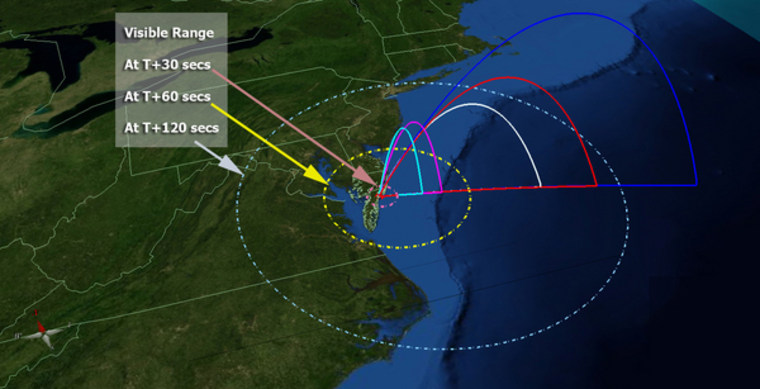NASA had to postpone its launch of a fleet of five unmanned suborbital rockets again early Friday, due to unacceptable weather and interference from boats near the launch site on the Virginia coast.
When the quintuple launch takes place, it's expected to put on a brief but impressive light show for people along the U.S. mid-Atlantic coast, who should be able to see glowing streaks from the rockets' vapor trails.
The Anomalous Transport Rocket Experiment, or ATREX, is designed to study high-altitude winds that blow at anomalously high velocities. Launch is highly dependent upon weather conditions at NASA's Wallops Flight Facility in Virginia and other observation points on the East Coast. Clear skies are needed for the launch to give the cameras the best possible view.
The $4 million mission has been delayed several times since its original launch date on March 14, first due to a radio glitch on one of the rockets, and then because of poor weather conditions.
The launch team at Wallops started a countdown on Thursday night but called it off early Friday. "Weather and boats not wanting to cooperate tonight," the Wallops launch team reported in a Twitter update.
NASA said the next launch opportunity under consideration would come on Saturday night, going into Sunday morning. A decision on whether to try to go ahead with liftoff at that time would be made later Friday, the space agency said. The range is available for the launch campaign through April 3.
When the mission proceeds, five rockets will blast off in just over five minutes to study high-altitude winds that can blow at staggering speeds of 300 mph (483 kilometers per hour) or stronger. This so-called upper-level jet stream is located between 60 to 65 miles (97 to 105 kilometers) above the Earth's surface.
These fast-moving winds are much higher and stronger than the jet stream commonly referred to in weather forecasts. Existing theories suggest that Earth's high-altitude jet stream should blow at just 50 mph (80 kilometers per hour), so the ATREX mission aims to examine why such a large discrepancy exists, researchers said. [Photos: NASA's ATREX Rocket Barrage Mission]
Each ATREX rocket is loaded with a chemical tracer, called trimethyl aluminum, which will help scientists map the winds. This chemical poses no threat to the environment or to human health, NASA officials said.
The rockets will be launched on five different trajectories, and will release the tracer material at altitudes between 50 to 90 miles (80 to 145 kilometers). This will create glowing, milky white clouds that could be visible for up to 20 minutes by people along the U.S. East Coast, from South Carolina to southern New Hampshire and Vermont, NASA officials said.
Two of the ATREX rockets will carry instruments to measure temperature and atmospheric pressure. Researchers will monitor three different cameras (one at the Wallops facility, one in North Carolina and one in New Jersey) to track the tracer clouds and calculate how quickly they move away from one another. These measurements will provide clues about what is powering these fast winds.
This report was updated by msnbc.com. Follow Space.com for the latest in space science and exploration news on Twitter and on .
